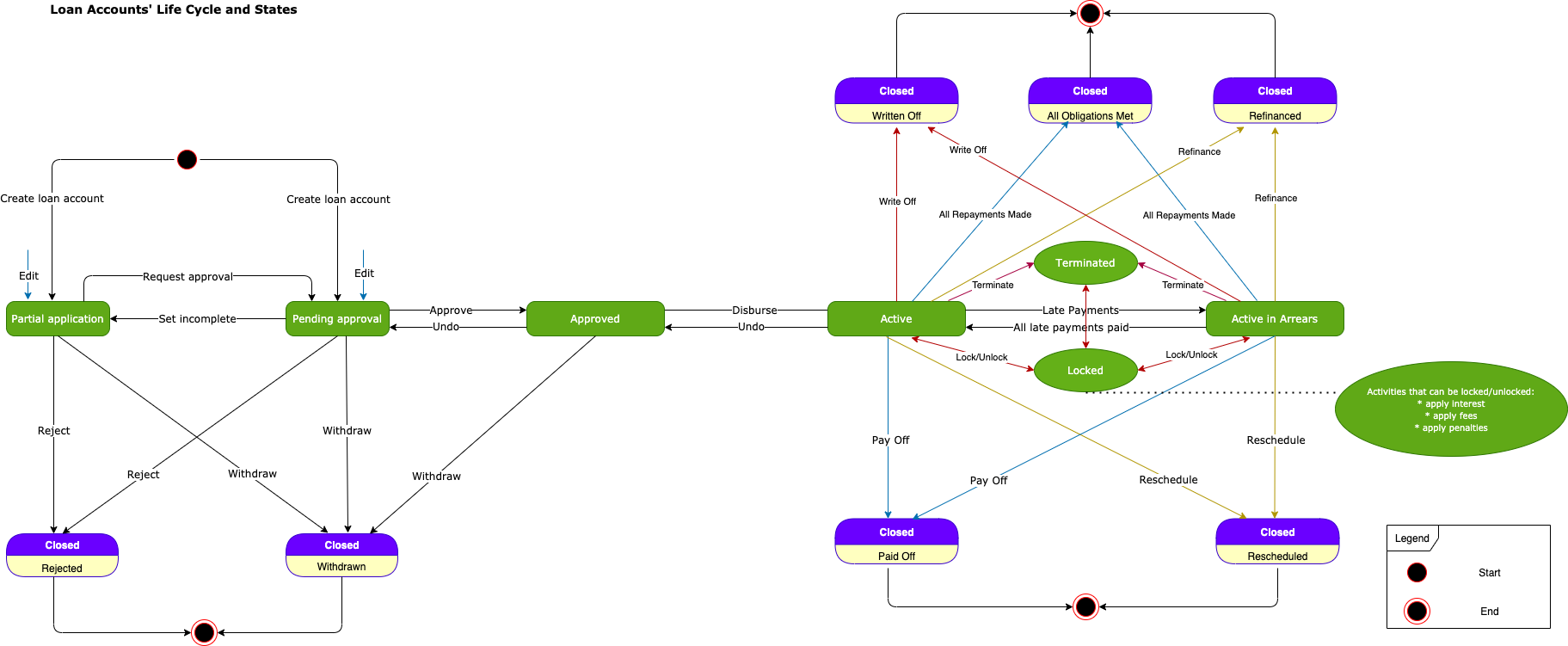- 16 Jul 2021
- 6 Minutes To Read
- Print
- DarkLight
- PDF
Loan Account Life Cycle and States
- Updated On 16 Jul 2021
- 6 Minutes To Read
- Print
- DarkLight
- PDF
From the moment you create a new loan account, it will go through different states, each of them with specific implications which are shown in the following diagram and described in more detail below.

Set up the initial state of a loan account
When setting up a new loan product, in the New Account Settings section of the form, choose what you want the initial state of the account to be: Partial Application or Pending Approval.
Partial Application
When a loan is in Partial Application, it means that the loan application is missing information and is not yet complete.
As soon as all the documents are collected and the application is complete, you can request approval which will set the loan account to Pending Approval state, so that it can be evaluated.
If at this stage a decision is made not to proceed with the application at all, it can be Rejected by the organization or Withdrawn by the client.
In this state it is still possible to edit the loan account terms, such as loan amount, interest rate, or number of installments.
Pending Approval
When a loan is Pending Approval, it means that the loan application is under evaluation and can be either:
- Approved
- Rejected (by the organization)
- Withdrawn (by the client)
- Set as Incomplete (if there is still information or documentation missing from the application, you can send the application back to
Partial Application).
In this state it is still possible to edit the loan account terms, such as loan amount, interest rate, or number of installments.
Reject an application
When an application is Rejected, the account will be automatically closed and classified as Closed (Rejected).
The loan account will remain associated to the client or group who requested it and all the information that was entered, like comments or notes will remain associated to the account allowing you to keep track of the reasons for the rejection.
This information can be used later, in case the client makes a new request and you want to consider it for the new evaluation process.
You can Undo Reject and send the account back to its previous state by selecting the option available under More.
Withdraw an application
If the client chooses to Withdraw the loan application, it will be automatically closed and classified as Closed (Withdrawn).
You can Undo Withdraw and send the account back to its previous state by selecting the option available under More.
Approved
Once all the account terms are evaluated and agreed upon, the loan application can be approved.
To approve a loan account, select Approve, add any comments you might have and confirm.
After being approved, the loan terms such as loan amount, interest rate, or number of installments cannot be changed anymore.
At this stage, the loan can either be Disbursed or can be Withdrawn by the client.
You can Undo Approve and send the account back to its previous state by selecting the option available under More.
Disburse a Loan
As soon as the application is approved, it's ready to be disbursed.
After being disbursed the loan account becomes automatically Active.
You can Undo Disbursement and send the application back to the Approved state by selecting the option available under More.
Active
This is the state of an account immediately after being disbursed.
It will remain in the Active state as long as the account remains in good standing.
Active (in Arrears)
When a loan account has at least one late repayment, Mambu will automatically change its state to Active in Arrears until all repayments are made.
The late repayments will then be displayed under each account's repayment schedule.
Locked
When there are unexpected events, or a client is having problems repaying a loan, you can lock the account and suspend interest, penalties and fees from being applied on the account.
When the account will be unlocked, the interest, fees and penalties that were accrued during the account locked state will be applied on the account.
Terminated
When you terminate a loan, the total outstanding principal plus all accrued charges become due immediately (as of the termination date).
This feature is currently available for:
- Dynamic Loans
- Interest calculation method: Declining Balance Equal Installments
- Pre-payment allocation: On upcoming pending installment only
- Pre-payment recalculation: Reduce Number of Installments (RNI)
- Types of fee allowed: Manual Fees only
To terminate a loan account, select Close > Terminate.
Add any notes you wish to this transaction for auditing purposes. These notes will be stored with the history of transactions for this account.
You can Undo Terminate and send the loan account back to its previous state by selecting the option available under More. The interest will still be applied, though.
Closed
Loan accounts can be closed in several situations presented below.
All Repayments Made
When the client finishes repaying all the installments, the account can be closed and will be stored under the client's profile as Closed (all obligations met).
Mambu will automatically calculate the "Completed Loan Cycles" whenever a loan account is closed with "All Obligations Met", meaning the loan has been either fully repaid or paid-off early.
Paid Off
When a client pays the whole amount of the loan earlier, the account can be closed for that client.
To pay off a loan account, select Close > Pay-off.
If part of the outstanding loan amount is not collected, you can choose to write off any remaining balances for interest, fees and penalties.
Add any notes you wish to this transaction for auditing purposes. These notes will be stored with the history of the transactions for this account.
The paid-off loan account will be stored under the client's profile as Closed (all obligations met).
Writen Off
When repayments are no longer expected on a loan account that is in arrears, it should be closed and written off.
To write off a loan account, select Close > Write off.
Add any notes you wish to this transaction for auditing purposes. These notes will be stored with the history of the transactions for this account.
The written off loan account will be stored under the client's profile as Closed (Written Off).
Rescheduled
If for instance, due to an unexpected event, a client is having problems repaying a loan, you can choose to reschedule the loan, therefore adjusting its terms in order to prevent it from going into arrears.
To reschedule a loan, select Close > Reschedule, add notes about the reasons for rescheduling and confirm the new state.
When you reschedule a loan, the current loan will be closed, its state will change to Closed (Rescheduled) and a new loan with the new terms will be automatically created with a link to the original account (this is often a requirement in an auditing process).
If the rescheduled account had interest, fees or penalties due, you can choose to either capitalize them on the new account principal balance or to writte them off when the new loan account is created.
Refinanced
If you decide to top-up a loan account, you can choose to refinance the loan by adding an additional amount to the current balance of the loan.
To refinance a loan, select Close > Refinance, add notes about the reasons for refinancing and confirm the new state.
When you refinance a loan, the current loan will be closed, its state will change to Closed (Refinanced) and a new loan account with the new terms will be automatically created with a link to the original account (this is often a requirement in an auditing process).
If the refinanced account had interest, fees or penalties due, you can choose to capitalize them on the new account principal balance or to write them off when the new loan account is created.


